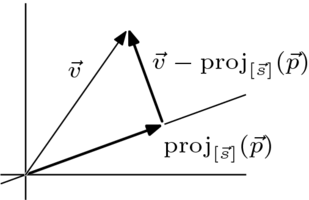Orthonormal Bases and the Gram-Schmidt Process
The prior subsection suggests that projecting onto the line spanned by decomposes a vector into two parts

|
that are orthogonal and so are "not interacting". We will now develop that suggestion.
Of course, the converse of Corollary 2.3 does not hold— not every basis of every subspace of is made of mutually orthogonal vectors. However, we can get the partial converse that for every subspace of there is at least one basis consisting of mutually orthogonal vectors.
The next result verifies that the process used in those examples works with any basis for any subspace of an (we are restricted to only because we have not given a definition of orthogonality for other vector spaces).
Template:AnchorBeyond having the vectors in the basis be orthogonal, we can do more; we can arrange for each vector to have length one by dividing each by its own length (we can normalize the lengths).
Besides its intuitive appeal, and its analogy with the standard basis for , an orthonormal basis also simplifies some computations.
Resources
- Gram-Schmidt Orthogonalization, Wikibooks: Linear Algebra


![{\displaystyle \displaystyle {\vec {v}}={\mbox{proj}}_{[{\vec {s}}\,]}({\vec {v}})\,+\,\left({\vec {v}}-{\mbox{proj}}_{[{\vec {s}}\,]}({\vec {v}})\right)}](https://wikimedia.org/api/rest_v1/media/math/render/svg/0da7af968d921768d5eef2f763959f0628fe2b2b)

